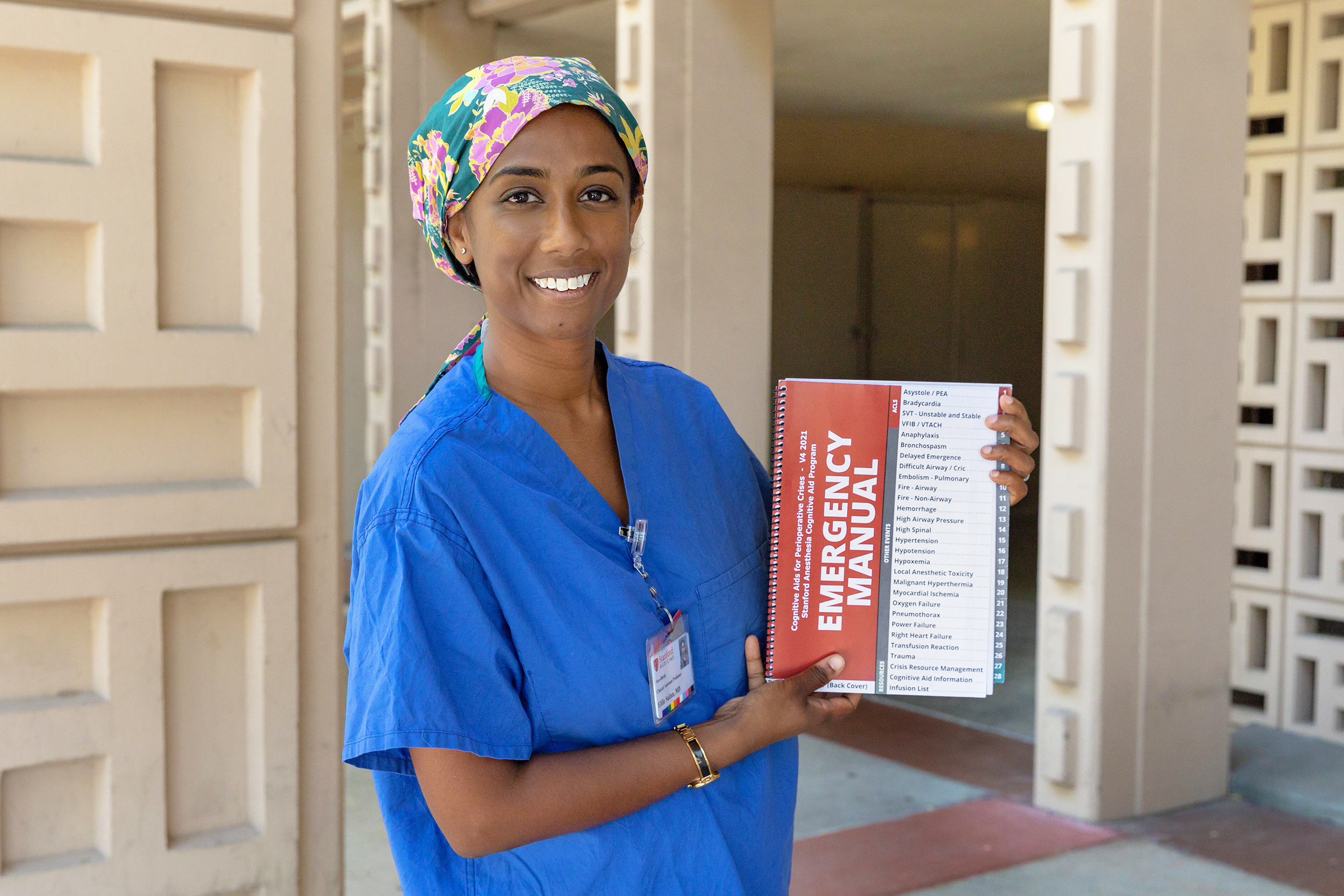

Stanford Anesthesia Cognitive Aid PROGRAM (SACAP)
Version 4 Team
-
Naola Austin, MD
Clinical Assistant Professor, Anesthesiology, Perioperative and Pain Medicine
Stanford Profile › -
Amanda Burden, MD, FASA, FSSH
Professor of Anesthesiology, Cooper Medical School of Rowan University
Cooper Profile › -
Barbara Burian, Ph.D.
Senior Research Psychologist, NASA Ames
Cognitive aid design & usability research
NASA Lab Profile › -
David Gaba, MD
Professor of Anesthesiology, Perioperative and Pain Medicine, Adult MSD
Stanford Profile › -
Sara Goldhaber-Fiebert, MD
Clinical Professor, Anesthesiology, Perioperative and Pain Medicine
Stanford Profile › -
-
Steven Howard, MD
Professor of Anesthesiology, Perioperative and Pain Medicine at the Palo Alto Veterans Affairs Health Care System
Stanford Profile › -
Ellile Sultan, MD
Clinical Assistant Professor, Anesthesiology, Perioperative and Pain Medicine
Stanford Profile ›
Citation: Stanford Anesthesia Cognitive Aid Program,* Emergency Manual: Cognitive aids for perioperative crises, Version 4, 2021. See http://emergencymanual.stanford.edu for latest version. Creative Commons BY-NC-ND (https://creativecommons.org/licenses/by-nc-nd/4.0/legalcode).
*Goldhaber-Fiebert SN, Austin N, Sultan E, Burian BK, Burden A, Howard SK, Gaba DM, Harrison TK.
Acknowledgements
This truly took a global village to launch Version 4 of the Stanford Emergency Manual. Dr. Meredith Hutton MD and Dr. Vladimir Nekhendzy MD made author-level contributions to content and usability of the Difficult Airway / Cric event. We appreciate the leadership, faculty, trainees, and staff at Stanford for their support of the development, implementation, and improvement of this emergency manual over the past decade. Many individuals contributed over the years.
For Version 4, we especially appreciate the detailed reviews of content, design, and usability, by our global expert physicians from 16 institutions and 8 countries.
Drs: Kelly Fedoruk, Brendan Flanagan, Anna Frackman, Ho Geol Ryu, Stephen Gleich, Christy Hong, Jeffrey Huang, Meredith Hutton, Xiavier Jiminez, Nirav Kamdar, Lena Koers, Matt Kurrek, Steve Lipman, Kenneth Lipshy, Raphael Lopes, Kirsty Maclennan, Stuart Marshall, Rebecca Minehart, Joe Mintz, May Pian-Smith, Milap Rakholia, Rafael Richards, Rodrigo Rubio, Isaac Brzezinski Sinai, Sven Staender, Pedro Tanaka, Lia Tron, Ankeet Udani, Catherine Ward, Javier Webar, Carolyn Weiniger, Louise Wen, David Whitaker, Becky Wong. For expert content review of specific events: Malignant Hyperthermia – Harvey Rosenbaum, Henry Rosenberg; Local Anesthetic Systemic Toxicity – Guy Weinberg. And for multiple proofreads of evolving versions – Joe Mintz.
Department of Anesthesia Web Development Contributors: Web Designer: Toni Benevento, Photographer: Rhee Bevere, Administrative Support: Summer Reid and Natalie Coupe.
Version 1 and Version 2 Team
Larry Chu, David Gaba, Sara Goldhaber-Fiebert, Kyle Harrison, Steve Howard
Version 3 Team
David Gaba, Sara Goldhaber-Fiebert, Kyle Harrison, Steve Howard
See prior versions for those acknowledgements.
How This Work Came to Be
This Emergency Manual has a long history, evolving from decades of prior work on both Crisis Resource Management (CRM) concepts and cognitive aids for critical incidents. The 1994 book entitled Crisis Management in Anesthesiology by Dr. David Gaba, Dr. Steven Howard, and Dr. Kevin Fish provided the initial foundations for this project. This simulation group was involved in developing cognitive aids for operating rooms in the Palo Alto VA and then a national VA project, each with bulleted points for many crises events.
Observing that practitioners often miss key actions under stress, Drs. Harrison and Goldhaber-Fiebert along with Dr. Geoff Lighthall, Dr. Ruth Fanning, Dr. Howard, and Dr. Gaba developed several iterations of pocket cards for perioperative crises events, including some with rhythm strips, icons, and color design. In 2004, Dr. Larry Chu conceived of adapting crisis management cognitive aids to a more visually striking format for a new book he envisioned for today’s highly-visual millennial learners. This became The Manual of Clinical Anesthesiology, published in 2011.
To create the current Emergency Manual, the Stanford Anesthesia Cognitive Aid Program was formed. All team members have had integral roles. Dr. Larry Chu, who directs the Stanford AIM (Anesthesia Informatics Management) lab, provided the new graphics and layout, applying his design skills and an understanding of user interface to make the content more easily usable. Drs. Sara Goldhaber-Fiebert, Kyle Harrison, Steven Howard, and David Gaba worked jointly to provide the content, including exact phrasing, ordering, and emphasis, as well as iterative simulation testing to revise both content and design elements.
Observing how cognitive aids are used by teams during hundreds of simulated crises has been crucial for pilot testing throughout. We hope that this Emergency Manual will support both education and patient safety efforts. Effective use has included pre-event review, post-event team debriefing, and ‘during’ crisis management – the latter, particularly after adequate help, has arrived or when the patient is sufficiently stable for a clinician to pause from acute care actions, and helped by a separate ‘reader’ role. We encourage the appropriate use of this Manual and welcome feedback from all practitioners.
Attribution
Much of the work in this Anesthesia Emergency Manual was adapted from cognitive aids originally published in Appendix of Crisis Management Algorithms in Anesthesia in the Manual of Clinical Anesthesiology, edited by Larry Chu and Andrea Fuller, published by Lippincott Williams & Wilkins, 2011. The authors were*: Harrison TK, (21) Goldhaber-Fiebert SN (21), and Chu L (21), as well as on specific cognitive aids, contributions by: Lighthall G, (2), Howard S (1), and Mudumbai S (1)*First three authors listed in random order; # of cognitive aids contributed to in original publication listed parenthetically.



